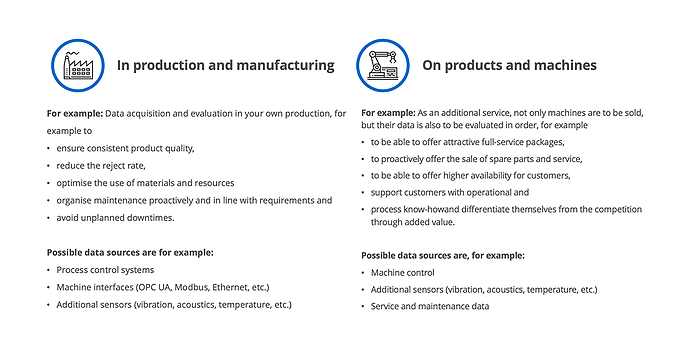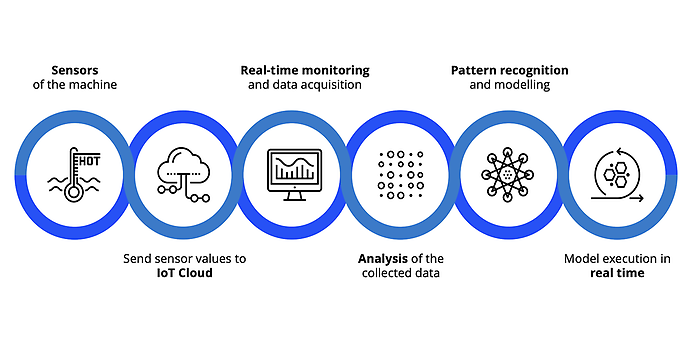19. June 2023 By Dr. Olaf Neugebauer
How predictive maintenance reduces downtime
Idle machines and expensive service calls and technician call-outs are the stuff of nightmares for industrial production.
But there are actually ways to counter this nightmare scenario: predictive maintenance can reduce machine downtime and the number of associated service calls. Modern machines have all kinds of sensors for detecting their conditions. Old machines can be retrofitted using retrofit sensors. These sensors are read out via standard interfaces, which in turn enable new types of algorithms and artificial intelligence (AI) to detect impending faults and thus predictively suggest maintenance.
This blog post marks the starting point for a small series in which I would like to introduce you to the topic of predictive maintenance and retrofit sensor technology.
What is predictive maintenance?
When it comes to industrial production and machines being used by customers, availability is essential. It is important is to reduce unplanned downtimes as much as possible or, ideally, to avoid them altogether. For particularly critical components, fixed maintenance schedules based either on experience or static models were established early on. However, these static models are often difficult to put into practice because they do things such as make assumptions about operating times and loads that are not applicable in the specific case at hand. On top of this, dynamic environments in which parameters are constantly changing are problematic for static models and fixed maintenance schedules.
Maintenance work and downtimes induce costs, which is why you want to control and plan them as precisely as possible. This gives rise to interesting scenarios:
- Has the component already reach the end of its life and is maintenance even necessary?
- What other components should also be serviced or replaced in order to avoid another costly technician call-out? This is particularly relevant for full-service maintenance contracts.
Or from the perspective of maintenance management:
- What is the best way to plan the technicians’ assignments?
- Which replacement parts should the technical personnel take with them and which need to be ordered?
- Which other components are often replaced/repaired at the same time or shortly after performing maintenance on the original component?
With the help of modern, networked sensor technology, the machines’ important condition parameters can be monitored in real time (condition monitoring). The terms ‘digital twin’ or ‘digital shadow’ are often used in this context. With the help of data science methods such as AI or machine learning, systems can be developed that recommend (semi-)autonomous and proactive maintenance. In technical terms, the latter is called ‘predictive maintenance’. Predictive maintenance ensures that critical components are maintained or replaced at the optimal time. When a technician is called out, additional components are serviced or replaced to avoid further costly call-outs.
Developing a good predictive model requires sufficient operational data from instances in which errors occurred. However, it often happens that this data is not available in a digital, structured form. This is the case in situations in which no data has been collected digitally so far or if the instance has been inadequately classified as an error case. That being said, one possible approach to using predictive maintenance is what is known as anomaly detection. With this approach, when a malfunction is detected, it is recognised as a deviation from the norm, the aim of which is to identify the malfunction at an early stage and initiate appropriate measures such as maintenance.
Below, I have summarised the most common reasons why you should use predictive maintenance.
Predictive maintenance in production and manufacturing
Here is an example to illustrate the point. You would like collect and evaluate data in your own production facility, for example, to
- ensure consistent product quality,
- reduce the number of products discarded due to quality issues,
- optimise the use of materials and resources,
- proactively organise your maintenance efforts and do so in line with demand as well as
- avoid unplanned downtimes.
Possible data sources include:
- process control systems,
- machine and control interfaces (OPC UA, Modbus, Ethernet and so on) or
- external sensors (vibration, acoustics, temperature and so on).
Predictive maintenance – products and machines
Here is an example to illustrate the point. You would like to offer data collection and evaluation as an additional, fee-based digital service in order to
- to be able to offer attractive full-service packages,
- proactively offer the sale of spare parts and services,
- ensure higher availability for your customers,
- also support your customers by means of operational and process expertise and
- utilise added values to make yourselves stand out from the competition.
Possible data sources include:
- machine control systems,
- external sensors (vibration, acoustics, temperature and so on) and
- service and maintenance data.

A typical analysis process in predictive maintenance systems
Once a predictive maintenance system has been set up, the process is always similar: first, the data is collected in a central system, such as our adesso IoT Cloud. As described above, possible sources include machine data, the service system, process control systems or an additional sensor system. A retrofit solution is particularly attractive for digitalising existing machines in a way that is cost-efficient because with these solutions, real-time monitoring is already possible.
This collected data must be analysed accordingly so that the predictive maintenance system can identify patterns and build a model that can be used to derive the condition of the machine and thus make recommendations for maintenance. In this context, a model that is both good and detailed is crucial for overall system quality.

Example of a predictive maintenance process flow in the context of your company
Many customers ask us how the flow of the predictive maintenance process can be mapped in their company and whether other sources of data are relevant in addition to sensor data. Other data sources offer immense added value and should definitely be considered. The data pipeline in your company could look like this:

The data sources are on the left. In this context, we often distinguish between static master data and historical or live data. The static master data comes from the peripheral systems, such as SAP, and contains the machines’ asset descriptions and maintenance history, among other things. It is precisely in these data sets that valuable information can be hidden. Perhaps the machine being considered has had certain faults several times in the past or has already undergone frequent repairs, so that future problems can also be deduced from this data?
The live data from the machines’ condition monitoring systems have to be considered too.
It is important that we make it so that all the data can be analysed. To this end, our experts often build up a what is known as a data lake. Every possible type of data pools together in this ‘lake of data’, often in an unstructured manner and therefore not assigned strict boundaries beforehand. The data scientists then begin work on this data lake with the help of frameworks and tools such as R or Python, among others.
The results of the data analysis are prepared in a way that makes them clear and are depicted in the visualisation layer (all the way to the right in the image). This is done, for instance, in the form of maintenance recommendations in the service dashboard or, in critical situations, as a push notification on the service technicians’ mobile phones. Another option is to use standard tools such as PowerBI or Tableau to give employees the opportunity to develop their own analyses and outlines in the sense of a self-service.
Why can data science be difficult when using real machine data?
If everything sounds so simple, why then are there no standard solutions for predictive maintenance? As rosy as the promises are, there are some pitfalls that should definitely be considered.
In the best case, it takes a long time for a machine to break down, but data scientists face a major challenge precisely because of this. Error conditions, in comparison, are rare and how many there are is not fully known, which means that traditional classification approaches cannot work efficiently or necessitate a strong reduction of the training data.
Another challenge when analysing real machine data is the small differences between individual systems or system types. However, it is often not economical to develop individual solutions for every possibility, instead, it makes more sense to provide a general model that does not have to be adapted for each product. This model can be further optimised at the time of application. This results in diverse challenges when developing a methodology for detecting and identifying the machines’ fault conditions.
In conclusion, predictive maintenance must always be seen as an extension of the existing service and be made to harmonise with the structures that already exist. It is important to note that predictive maintenance is never intended to replace existing employees but rather it provides assistance with production-related availability and optimisation.
We would be happy to help you with your project. Feel free to get in touch with us.
You can find out more about IoT at adesso on our website or in our blog posts on IoT.
You can find more exciting topics from the world of adesso in our latest blog posts.

